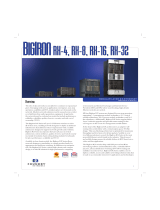
PRIMARY FEATURES AND BENEFITS
Performance & Scalability
Today’s enterprise organizations require
cost-effective, exible, and secure
solutions for delivering data and unied
communication services on a network
architecture that can scale and evolve
to meet their ever-changing needs. The
FastIron GS Series is designed to meet
these requirements. Its wire-speed
architecture delivers non-blocking
performance for high-speed Gigabit
Ethernet desktops while providing QoS
assurances at VoIP endpoints.
Convergence planning and deployment
can occur over an extended period, and
budget constraints may require phased
deployments. The FastIron GS Series makes
it easy to deploy a solution today that can
be upgraded later to support PoE, 10-GbE,
and stacking as needed.
Each power supply in a FastIron GS switch
delivers up to 480 watts of PoE power.
In a dual power supply conguration, up
to 48 10/100/1000 Mbps PoE ports of
15.4 watts per port (full Class 3) can be
supported. This scalability enables the
network manager to size the installation
to meet current needs and still have room
for future growth.
As network trafc increases, network
managers can easily upgrade to 10-GbE
to provide high-capacity connectivity
to the network backbone and/or high-
performance servers. The FastIron GS can
be upgraded in the eld with a two-port
10-GbE XFP/CX4 module.
The optional 10-GbE module is offered in
three eld upgradable models: the FastIron
GS-2XG supporting two small form factor
pluggable XFP transceivers, the FastIron
GS-2XGC supporting two CX4 connectors,
and the FastIron GS-1XG1XGC supporting
a combination of an XFP transceiver and a
CX4 connector. Supported XFP transceivers
include SR, LR, ER, ZR, and ZRD optics
supporting ber lengths up to 80Km.
For cost-effective and rapid scaling at
the network edge, the FastIron GS is
upgradeable with the Brocade IronStack
stacking technology, which supports
stacking up to eight units in a virtual
chassis. The FastIron GS IronStack system
supports 40-Gbps switching capacity
between stacked units, providing a high-
capacity interconnect across the stack.
FastIron GS IronStack supports stacking
over copper and ber cables. This allows
exible stack congurations in which
stacked units can be separated by more
than several hundred meters of ber.
High Availability Hardware Features
Convergence solutions serving VoIP require
high availability, especially for the power
supplies that power the PoE interfaces.
FastIron GS switches fulll this requirement
with dual, hot-swappable AC or DC power
supplies. Both redundant AC and redundant
DC power congurations are included.
The FastIron GS Series features 1+1 power
redundancy, using hot-swappable and eld
replaceable power modules, which install
into the back of the unit. The power modules
are load-sharing supplies providing full 1+1
redundancy for as many as 48 Class 1 and
Class 2 PoE ports and 31 Class 3 (15.4 watts)
PoE ports.
Additional design features include intake
and exhaust temperature sensors and fan
spin detection to aid in rapid identication
of abnormal or failed operating conditions
to help minimize mean time to repair.
The Brocade Ironstack Solution
The FastIron GS series may be ordered
pre-congured with the Brocade IronStack
stacking technology or upgraded in the
eld. IronStack is an advanced stacking
technology that supports stacked
congurations in which as many as eight
FastIron GS and/or FastIron LS switches
can be interconnected while maintaining the
operational simplicity of a single switch. An
IronStack stack can be a mix-and-match of
different FastIron GS and FastIron LS switch
models providing for very exible stack
congurations. Each IronStack enabled
FastIron GS or LS model can support up
to 40Gbps of stacking bandwidth per
unit. IronStack congurations can be
built using 10-GbE CX4 copper or XFP-
based ber connections. When XFP-based
ber connections are used, an IronStack
conguration can be extended between
racks, oors, and buildings with ber
lengths up to several hundred meters.
The FastIron GS STK models are pre-
congured with a two-port 10-GbE CX4
module, expanded CPU memory, an
IronStack license (IronStack PROM) and
software. The CX4 module in the STK models
can be replaced in the eld with any of the
optional 10-GbE modules available for the
FastIron GS.
An IronStack system operates as a
single logical chassis (with a single IP
management address) and supports cross-
member trunking, mirroring, switching,
static routing, sFlow, multicast snooping and
other switch functions across the stack. An
IronStack stack has a single conguration
le and supports remote console access
from any stack member. Support for
active-standby controller failover, stack link
failover, and hot insertion and removal of
stack members delivers the resilience that
is typical of higher end modular switches.












